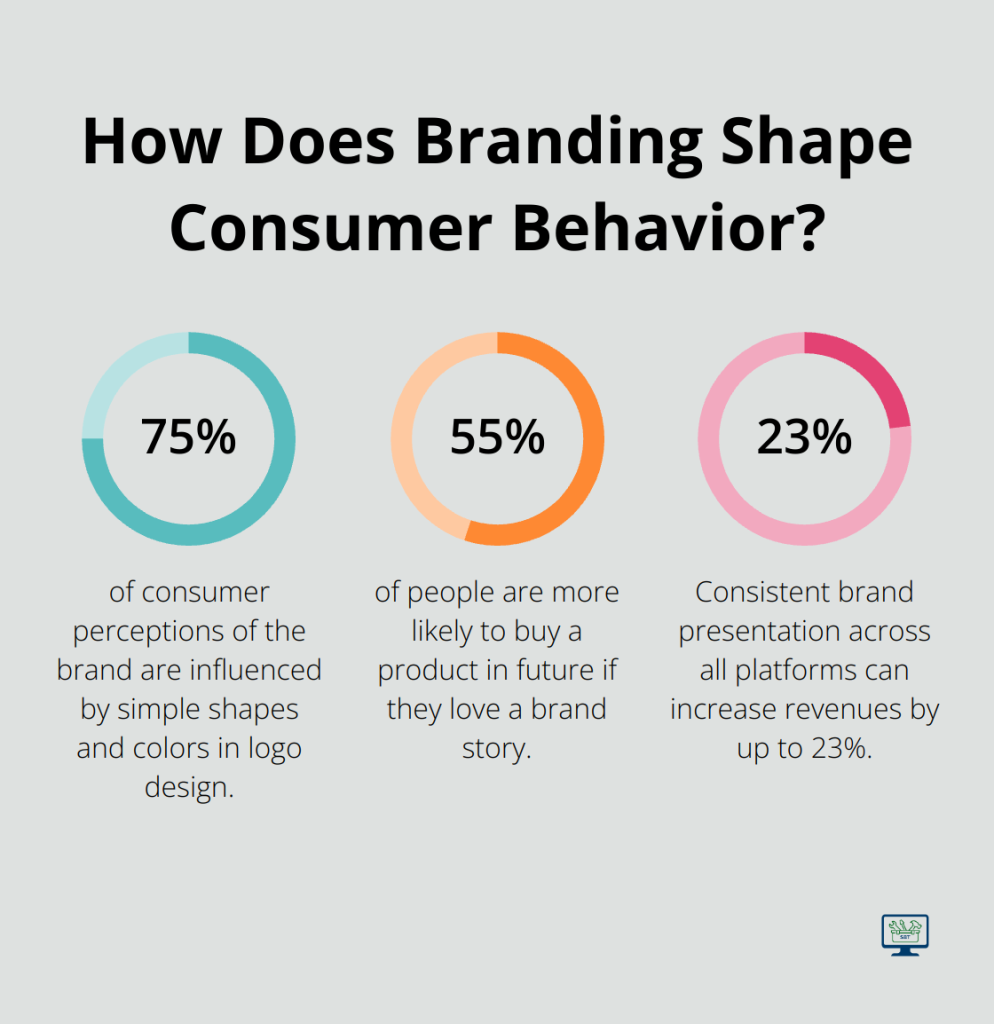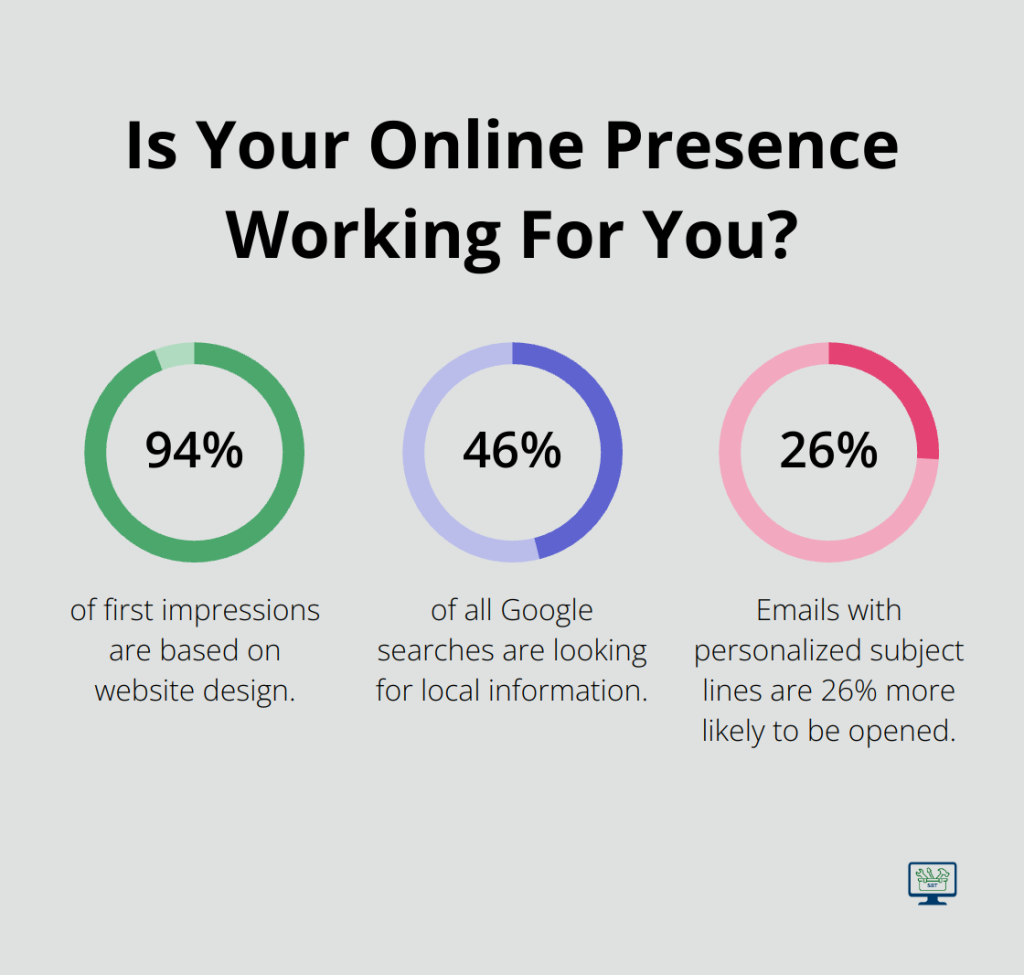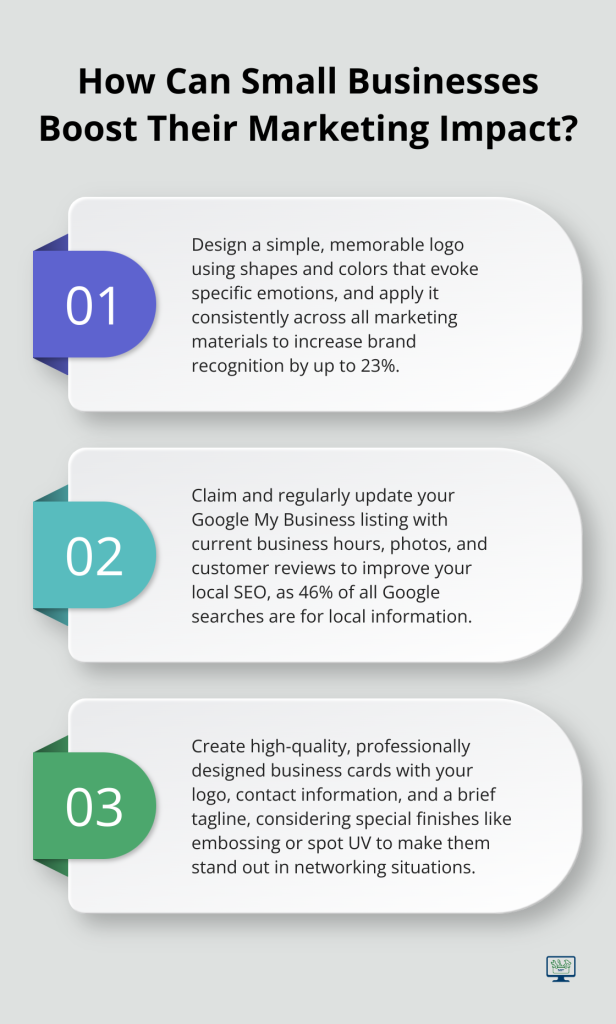Marketing can make or break a small business. At SmallBizToolbox, we’ve seen countless entrepreneurs struggle to identify the most important marketing items for their ventures.
This guide will walk you through the essential small business marketing items you need to succeed. From branding basics to digital must-haves, we’ll cover everything you need to get started and grow your business effectively.
How to Build a Strong Brand Identity
Craft Your Unique Logo and Visual Style
Your logo serves as the face of your business. It’s the first element customers see and remember. Using simple shapes and colors in logo design can evoke specific emotions and associations, influencing 75% of consumer perceptions of the brand. Invest in a logo that’s simple, memorable, and reflects your business values.

Select colors that align with your brand personality. Blue often conveys trust and professionalism, while green is associated with growth and eco-friendliness. A consistent color palette across all marketing materials strengthens brand recognition.
Tell Your Brand Story
Your brand story sets you apart. It’s not just about what you sell, but why you exist and what you stand for. A study by Headstream found that if people love a brand story, 55% are more likely to buy the product in future.
Define your mission statement. What problem does your business solve? Why did you start your company? Share this story on your website’s ‘About Us’ page and incorporate it into your marketing materials.
Create Brand Guidelines
Brand guidelines ensure consistency across all your marketing efforts. They act as a rulebook for your brand’s visual and verbal identity. According to a study by Lucidpress, consistent brand presentation across all platforms can increase revenues by up to 23%.
Your brand guidelines should include:
- Logo usage rules (size, placement, variations)
- Color palette with specific color codes
- Typography (fonts for headings and body text)
- Tone of voice for written content
- Image style for photos and graphics
Building a strong brand identity is an ongoing process that evolves with your business. Review and update your branding regularly to stay relevant and appealing to your target audience.
Implement Your Brand Across All Touchpoints
Once you’ve established your brand identity, it’s time to implement it across all customer touchpoints. This includes your website, social media profiles, email signatures, and physical marketing materials (business cards, brochures, etc.).
Consistency is key. When customers encounter your brand, they should have a seamless experience whether they’re visiting your website, reading your email newsletter, or picking up your business card at a networking event.
Now that you’ve laid the foundation for your brand identity, let’s explore how to create an effective online presence to showcase your brand to the world.
How to Build a Powerful Online Presence
Create a User-Friendly Website
Your website often serves as the first point of contact between your business and potential customers. A study reveals that 94% of first impressions are based on website design. Start with a clean, mobile-responsive design that loads quickly. Google reports that 53% of mobile users abandon sites that take longer than three seconds to load.

Include clear calls-to-action (CTAs) on every page. Whether it’s “Buy Now,” “Contact Us,” or “Learn More,” guide your visitors towards the next step. Make your contact information easily accessible – preferably in the header or footer of every page. Write clear, concise, and valuable content for your visitors. Use headers to break up text and improve scannability. Include high-quality images and videos to enhance user experience.
Master the Art of SEO
Search Engine Optimization (SEO) plays a vital role in getting found online. Start by researching keywords relevant to your business using tools like Google Keyword Planner. Incorporate these keywords naturally into your website content, meta descriptions, and image alt tags.
Local SEO holds particular importance for small businesses. 46% of all Google searches are looking for local information. Claim your Google My Business listing and keep it updated with your latest business hours, photos, and customer reviews.
Harness the Power of Social Media
Social media platforms offer unparalleled opportunities to connect with your audience. Choose platforms where your target customers are most active. For B2B businesses, LinkedIn might prove more effective, while visual businesses might thrive on Instagram or Pinterest.
Consistency is key in social media marketing. Use tools like Hootsuite or Buffer to schedule posts in advance. Try to create a mix of promotional content, industry news, and engaging questions to spark conversations with your followers. Announce new products or services to generate excitement. Include high-quality images or videos to showcase what you offer.
Launch Effective Email Campaigns
Email marketing remains one of the most cost-effective digital marketing strategies. A study found that marketers’ ROI estimation remained strong in 2020 at £35.41 for every £1 spent. Start by building your email list through sign-up forms on your website and social media profiles.
Segment your email list based on customer preferences or behavior to send more targeted, relevant content. Use compelling subject lines – CoSchedule found that emails with personalized subject lines are 26% more likely to be opened.
Building an effective online presence requires time and consistent effort. These foundational elements (website, SEO, social media, and email marketing) form the cornerstone of a strong digital strategy. Tools like Google Analytics can provide valuable insights into your website performance and user behavior, helping you make data-driven decisions to improve your online presence. As you master these digital essentials, you’ll be well-prepared to explore the next critical aspect of small business marketing: creating tangible marketing materials that reinforce your brand in the physical world.
What Marketing Materials Do Small Businesses Need?
Physical marketing materials play a vital role in promoting small businesses, even in the digital age. These tangible items reinforce brand identity and create lasting impressions on potential customers. Let’s explore the essential marketing materials every small business should consider.
Business Cards: Your Pocket-Sized Brand Ambassador
Business cards remain vital in creating tangible connections and lasting impressions. Small businesses should invest in high-quality, professionally designed cards that reflect their brand identity. Include your logo, contact information, and a brief tagline or unique selling proposition. Special finishes like embossing or spot UV can make your cards stand out. For eco-conscious businesses, recycled paper or seed paper cards can make a memorable impression.
Brochures and Flyers: Informative Brand Storytellers
Brochures and flyers are versatile marketing tools that allow businesses to provide detailed information about their products or services. When designing brochures, focus on clear, concise messaging and high-quality images. Use infographics to present complex information in an easily digestible format. For flyers, a bold headline and a strong call-to-action are essential to grab attention and drive action.
Signage and Banners: Your Visual Storefront
Effective signage can significantly increase brand visibility, drawing the attention of passersby. Brick-and-mortar businesses should invest in a well-designed storefront sign that’s visible from a distance. For events or trade shows, roll-up banners or backdrop displays can create a professional booth setup. Always ensure your signage is consistent with your brand guidelines and clearly communicates your business name and key offerings.
Promotional Products: Tangible Brand Reminders
Promotional products (such as pens, mugs, or USB drives) serve as long-lasting brand reminders. Choose items that align with your brand and provide value to your target audience. Quality matters more than quantity – it’s better to invest in fewer, high-quality items than to distribute large quantities of cheap, forgettable products.
Packaging: The Unboxing Experience
For businesses that ship products, packaging is a critical marketing material. It’s not just about protection; it’s about creating an unboxing experience. Consider custom boxes, tissue paper, or thank-you notes to enhance the customer experience and reinforce your brand identity. When pricing your products, remember to factor in the cost of quality packaging to ensure profitability while delivering a memorable experience.

Final Thoughts
Small business marketing items form the foundation of a strong brand identity and customer attraction strategy. Each element, from logos to websites to business cards, communicates your brand’s value and personality. Consistency across all marketing materials builds trust and recognition, leading to stronger customer relationships and increased sales.

We at SmallBizToolbox understand the challenges of marketing a small business. Our platform provides a comprehensive suite of tools and resources designed to help Australian entrepreneurs succeed. SmallBizToolbox offers AI-driven content creation, SEO optimization, and social media aids to boost your online presence and operational efficiency.
Effective marketing is an ongoing process that requires continuous refinement and adaptation as your business evolves. Start with the basics (a well-designed logo, user-friendly website, and professional business cards) and expand your marketing toolkit over time. This approach will equip you to attract customers, build brand loyalty, and drive your small business towards success.
How useful was this Resource?
Click on a star to rate it!
Average rating 0 / 5. Vote count: 0
No votes so far! Be the first to rate this post.
We are sorry that this post was not useful for you!
Let us improve this Resource!
Tell us how we can improve this Resource?




